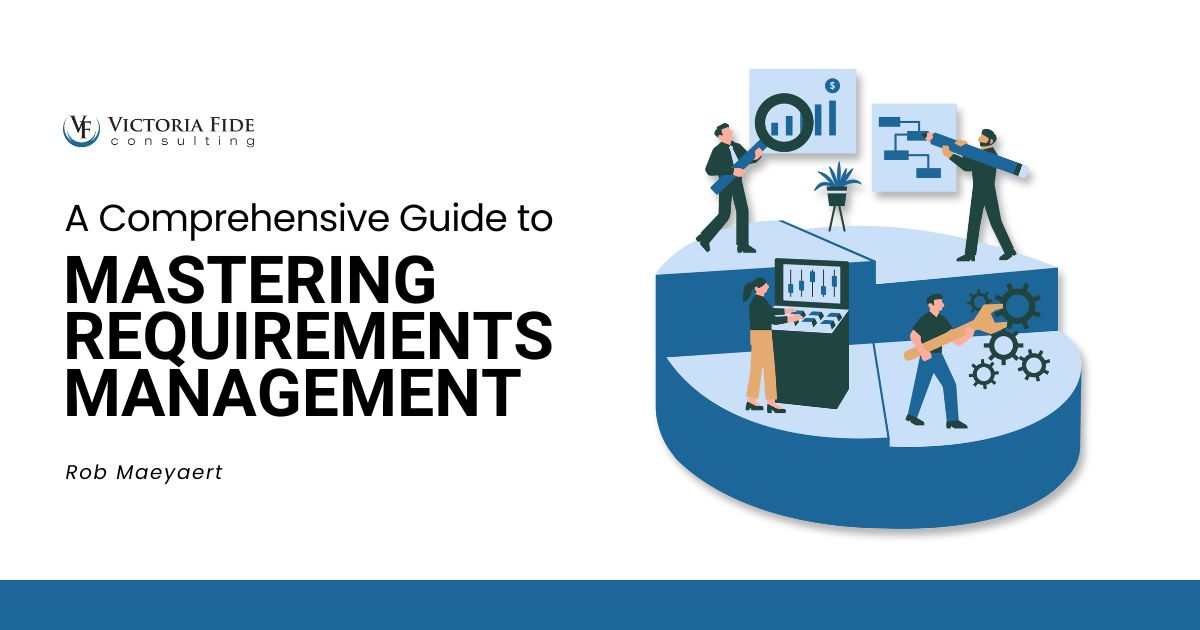
A Comprehensive Guide to Mastering Requirements Management
Imagine constructing a grand, intricate building. Before the walls can rise, before the windows are installed, and before the roof is erected, a solid foundation must be established. In the world of business analysis and project management, business requirements serve as this essential foundation. Without clear, well-defined requirements, the entire structure of your project is at risk, much like a building without a stable base.
To build out a future state solution, you need to be able to effectively design it, which necessitates properly defined requirements. Requirements act as the building blocks, providing the necessary support and clarity for every subsequent step in the process. This article delves into the importance of business requirements, the steps to document them, and other essential considerations to ensure that your projects are built on solid ground.
Table of Contents
What is a Business Requirement?
A business requirement is a statement of what a business needs to achieve its desired outcomes. It is expressed in terms of the outcomes the business requires, rather than the specific functions a system may perform. Business requirements guide the development of processes, systems, and solutions to meet business goals. They are critical in ensuring that everyone has a common understanding of what needs to be accomplished and why it is important.
Business requirements are documented in a specific format, which serves as a blueprint for the solution. These requirements can include various aspects such as business rules, reporting needs, compliance requirements, and any constraints or assumptions that must be considered.
Why is a Business Requirement Important?
The importance of having well-defined, clear business requirements cannot be overstated. Clear requirements serve as the cornerstone for successful project execution and delivery. They provide a precise understanding of what needs to be achieved, setting clear expectations for stakeholders, project teams, and developers. When requirements are unambiguous and straightforward, they minimize the risk of misinterpretation and ensure that everyone is on the same page.
Furthermore, clear business requirements facilitate effective communication among all parties involved. They form the basis for accurate project planning and estimation, allowing teams to allocate resources efficiently and set realistic timelines. This clarity helps in identifying potential challenges early in the project lifecycle, enabling proactive risk management and mitigation.
In addition, well-defined requirements support better decision-making throughout the project. They provide a framework for evaluating potential solutions, ensuring that the chosen approach aligns with the business objectives and delivers the desired outcomes. Clear requirements also aid in measuring progress and success, offering tangible criteria against which project performance can be assessed.
Ultimately, the clarity of business requirements drives project success by ensuring that the final solution meets the business needs and adds value to the organization.
Characteristics of a Business Requirement
A well-defined business requirement should have three characteristics: Clear, Necessary, and Verifiable.
1. Clear
It is important that requirements are clear and concise. There should be no ambiguity, and they should be short and to the point.
- Incorrect: Should be able to email document to vendor automatically from order or be able to manually send document
- Correct: Ability for a purchase order confirmation to automatically email to the configured vendor contact
- Correct: Ability to manually email a purchase order confirmation to a specified email address
2. Necessary
If a good reason can’t be provided on why it’s needed, it’s not a good requirement. Ensure that the requirements don’t include unnecessary implementation details.
- Incorrect: All vendors with a C quality rating need to appear yellow in the vendor list
- Correct: Ability to identify vendors with a C quality rating when viewing the vendor list
3. Verifiable
A requirement must be testable so that it is easy to determine if it has been met.
- Incorrect: Need to be able to see if the right item is received
- Correct: Purchase Order Receiving app on scanner must require an item number confirmation before the receipt can be posted
Activity: Building Business Requirements from Use Case Scenarios
Distilling various business needs or wants into clear, necessary, and verifiable requirements that will drive solution design can be much more challenging than it sounds. It takes experience and practice to become proficient in creating effective requirements, especially when the information provided is vague or misleading.
In this section, we will provide three business use case examples from a fictional company, Zycon Industries. Each example will emulate the type of communication businesses often provide when asked to produce business requirements. You can then practice formulating specific business requirements from each example, and then click the drop downs to compare your answers to the final requirements chosen for the company.
This exercise will be particularly helpful for business analysts or similar roles who are responsible for building requirements in process design sessions or interviews with Subject Matter Experts (SMEs) and Business Process Owners (BPOs).
Example #1: Assessing Finance Charges
Zycon Industries specializes in producing high-quality metal parts and components for various industries. They have upwards of 100 customers and plan to double in size over the next several years. They offer different payment terms to their customers, which could vary from Net 10 to Net 60. If a customer does not pay on time, they want the ability to assess finance charges, while putting a soft hold on the customer account that would require supervisor review of the sales order prior to being approved and processed.
» Click to View Specific Business Requirements
- Ability to manage multiple payment terms
- Ability to assign a specific payment term to a customer
- Ability to assess finance charges for overdue accounts
- Ability to place a soft hold on customer accounts for overdue payments
- Ability to trigger a supervisor review when a new sales order is entered for an account that is on hold
Example #2: Shipping Raw Materials to Meet Demands
Zycon Industries wants to continue to expand their manufacturing operations. They have manufacturing facilities in several different geographies and want to have the ability to transfer raw materials to any facility if needed. They want to assess safety stock levels and upcoming order demands and be able to ship raw materials weekly to meet those demands at every facility.
» Click to View Specific Business Requirements
- Ability to track raw material inventory across multiple facilities in real-time
- Ability to define safety stock levels by material and facility
- Ability to automate the transfer of raw materials between facilities based on demand and safety stock levels
- Ability to group transfer requirements within a single week to minimize shipping costs
Example #3: Leveraging Subcontractors
In the manufacturing process, Zycon Industries may need to send a component to a subcontractor for additional fabrication or tooling. Zycon needs the ability to facilitate this handoff and return from the subcontractor. Since a portion of the manufacturing process is outsourced and quality is more difficult to maintain, there is a greater chance that rework will be necessary. Zycon needs the ability to manage and monitor this quality. If quality standards dip for an extended duration, the fee to the subcontractor may be reduced, or a different preferred subcontractor will be utilized for future orders.
» Click to View Specific Business Requirements
- Ability to track raw material inventory across multiple facilities in real-time
- Ability to automate the transfer of raw materials between facilities based on demand and safety stock levels
- Ability to subcontract a portion of the manufacturing process for a component
- Ability to send raw materials to a subcontractor for use in fabricating a component
- Ability to receive a fabricated component from a subcontractor
- Ability to monitor and manage the quality of outsourced fabrication
- Ability to adjust subcontractor fees
- Ability to easily switch between preferred subcontractors for a specific component
The Role of Documenting As-Is Business Processes
A crucial step in being able to develop specific business requirements is to begin by documenting the current or “as-is” business processes. The as-is state provides a comprehensive snapshot of the current operations, highlighting existing workflows, systems, and procedures. This foundational understanding is indispensable for building specific business requirements.
Documenting the as-is processes allows stakeholders to identify and understand the current pain points, inefficiencies, and performance bottlenecks. This analysis forms the bedrock upon which specific business requirements for future processes can be designed, ensuring that the to-be processes are not just innovative but also address the core issues that hinder current operations.
Improving Quality Through a Requirements Management Approval Process
In addition to documenting business requirements, it is imperative to establish a robust requirements management approval process. This process ensures that all business requirements are meticulously reviewed, validated for accuracy, and ultimately approved before proceeding to the solution design phase.
Firstly, a formal approval process fosters accountability and thoroughness. By involving multiple stakeholders in the review process, businesses can leverage diverse perspectives and expertise, thereby identifying potential issues and discrepancies early on. This collaborative scrutiny helps ensure that the requirements are comprehensive, clear, and aligned with the organization’s strategic objectives.
Secondly, an approval process serves as a quality control mechanism. It verifies that the documented requirements are not only accurate but also necessary and feasible. By rigorously evaluating each requirement, the process mitigates the risk of misunderstandings and ensures that the solutions designed are grounded in actual business needs and constraints.
Additionally, having a structured approval process enhances communication and transparency. Stakeholders are kept informed and engaged throughout the requirements phase, fostering a sense of ownership and commitment to the project. This shared involvement is crucial for securing consensus and support for the ensuing solution design and implementation stages.
This approval process helps to prioritize requirements based on their importance and impact. By systematically reviewing and approving requirements, businesses can allocate resources more effectively and focus on delivering high-value outcomes.
Categorizing Requirements for Increased Efficiency
In documenting business requirements, it is crucial to understand how to categorize them. Each requirement should be clearly associated with the end-to-end process it pertains to. This association helps in pinpointing where in the workflow the requirement fits, making it easier to trace and manage during solution design.
It’s also important to recognize that not all documented requirements may fall within the scope of the current project. Nevertheless, these requirements should still be meticulously recorded, as they may prove valuable for future initiatives. This forward-thinking approach ensures that all potential needs are captured and can be revisited as the project evolves or as new projects arise.
Prioritizing business requirements is a vital aspect of requirements management. Not all requirements carry the same weight; some are more critical to the project’s success than others. By prioritizing these requirements based on their importance and impact, businesses can allocate resources more effectively and focus on delivering high-value outcomes.

Transformation is not easy, but it doesn’t have to be impossible. Take control of your project’s success today and schedule a free 30-minute consultation to find out how Victoria Fide can equip you for transformational success.
Building a Firm Foundation to Reach New Heights
In conclusion, the structured approval process for business requirements serves as a crucial cornerstone for project success, much like the foundation of a well-built skyscraper. By fostering accountability and thoroughness through diverse stakeholder involvement, it ensures that requirements are comprehensive and aligned with organizational goals. Acting as a quality control mechanism, it verifies the accuracy and feasibility of requirements, thus mitigating risks and grounding solutions in real business needs.
This process enhances communication and transparency, engaging stakeholders and fostering a sense of ownership and commitment. This collaborative approach is essential for reaching alignment and support for subsequent project stages. Prioritizing requirements based on their importance and impact allows for more effective resource allocation, ultimately delivering high-value outcomes.
By categorizing and meticulously documenting requirements, even those outside the current project’s scope, businesses ensure that potential needs are captured for future initiatives. This forward-thinking strategy, coupled with a rigorous approval process, builds a strong foundation for sustained success, much like the strategic planning and meticulous execution that turn architectural blueprints into enduring structures. The careful management of business requirements is not just a procedural necessity but a strategic imperative that transforms visionary plans into tangible achievements.

About the author
Rob Maeyaert is a Director of Project Portfolio and Change Management at Victoria Fide Consulting. For more than 20 years he has worked to help companies implement complex technology solutions and drive their strategic business objectives. For Rob, the most rewarding part of the client journey is building that trusted advisor relationship. Rob works hard to build that through honesty, integrity, and ensuring commitments are followed through.
